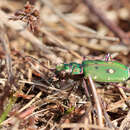en
names in breadcrumbs


Cicindela campestris, commonly called the green tiger beetle,[1] is a widespread Eurasian species of tiger beetle. It is the type species of the large genus Cicindela.
Adults are typically 12–15 millimetres (0.47–0.59 in) long. The elytra and thorax are green, varying in tone from light to dark, spotted with cream-coloured patches, and in bright sunlight are somewhat iridescent. The eyes are blackish; the legs are brown with whitish hairs. The antennae are long and straight, not clubbed.
The adults are sun-loving. They live in places with dry soils (sandy or chalky), mostly between May and October at the latitude of Britain. Like other tiger beetles, they run fast on their long legs and are most often seen on bare ground, in Britain typically on heather moorland. They can fly fast, making a loud buzzing noise.[2] It can run at speeds of 60 cm per second.[3]
Cicindela campestris is distributed across Europe from Spain in the southwest to Finland in the northeast. Most records are from the UK, Germany, Austria and the south of Sweden. In Britain, records are mainly from dry sandy or heathy areas such as the heathlands of Surrey, Hampshire and Dorset, and the mountains and moorlands of the Scottish Highlands.[4]
The species is divided into several subspecies:
The mollicute bacterium species Entomoplasma freundtii (Entomoplasmatales, Entomoplasmataceae) can be isolated from the green tiger beetle.[5]
Chinery, Michael. Collins Complete Guide to British Insects. Collins, 2005. ISBN 978-0-00-729899-0
 Mating pair. Male grips female at back of thorax with his (pale-coloured) mandibles
Mating pair. Male grips female at back of thorax with his (pale-coloured) mandibles Cicindela campestris, commonly called the green tiger beetle, is a widespread Eurasian species of tiger beetle. It is the type species of the large genus Cicindela.